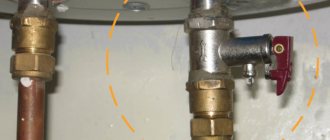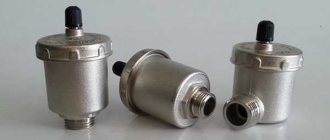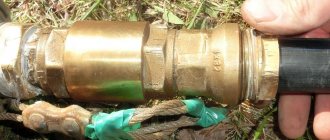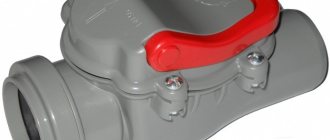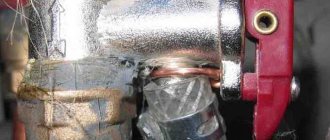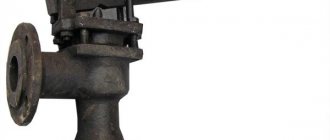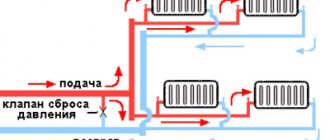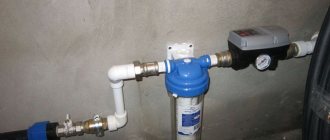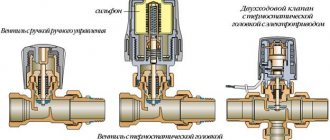What is a balancing valve
For valves of this type, balancing is a change in the working cross-section of the pipeline. This is achieved by extending the rod into the working area of the structure through which the coolant flow passes. As a result, a change in pressure occurs, hydraulic normalization.
Outwardly, it resembles conventional shut-off and control valves. But for precise adjustments there is a digital scale on the lid. The design has fittings for connecting measuring instruments or a differential pressure regulator.
Features of work, purpose:
- The basic setting is carried out based on the hydraulic calculation of the system. In the future, it is possible to change the parameters for precise control.
- Installed in complex heating systems with several central risers.
- It is not used in collector heating, since balancing occurs automatically there.
- Not used in small autonomous heating systems, for houses with an area of less than 300 m².
There are differences for each model of balancing valve for a heating system - operating principle, design, ability to connect with other elements. The relevance of its installation is determined at the design stage. It is required for heat supply to apartment buildings, commercial and industrial buildings.
Important: the balancer is useless for an open heating system. It is installed only for closed lines with forced supply of coolant.
Types of shut-off and control valves
Each system must have the ability to isolate any part of it. This may be necessary both for repair work and for modernization or refurbishment. Of course, you can turn off the whole thing, but a shut-off valve . After all, shut-off and control valves of various types were developed specifically for such situations.
| Single and double saddle | A plunger is used to change the flow pressure. This type provides high tightness |
| Cellular | The flow pressure is adjusted through the use of a cellular cage. These valves do not make noise or vibrate during operation. |
| Membrane | Flow intensity is controlled through the use of membranes made of elastic materials. Unlike other valves, they are not subject to corrosion |
| Spool valves | Often called shut-off valves. As the name suggests, the valve uses a spool as a regulating element |
Valves are also differentiated according to their design. They can be needle-shaped or angular direct-flow.
Valves that can not only shut off the flow, but also regulate its intensity, are widely used in thermal energy and in the creation of thermal systems. These can be both heating systems and air conditioning and ventilation systems. This type of shut-off and control valves can be used in the chemical, petrochemical and food industries.
Control valves can be controlled using pneumatic, electric and electromagnetic actuators.
The shut-off control valve allows not only to completely shut off the flow in the system, but also to regulate its intensity. In addition, this type of valve allows you to shut off the flow immediately, with one movement of your hand. This is a great advantage in the event of an emergency. The valves are controlled using pneumatic and electric actuators.
They are usually made from stainless materials, cast iron, brass and aluminum. The use of these materials significantly extends the period of effective operation of the crane.
Our company offers you high-quality fittings!
The main criterion by which fittings are selected is reliability and absence of malfunctions. When purchasing components, you need to be sure that they will work exactly as needed, without failures or breakdowns.
offers customers to purchase high-quality shut-off valves at the most affordable prices. By purchasing fittings from Salutech, you receive guaranteed quality service:
- low prices
- detailed consultations
- only high-quality products from well-known manufacturers
- the ease with which you can order
- Fast shipping
A system of individual discounts is possible for regular customers.
Why use it
The main task is hydraulic balancing. Example: in an apartment building there are two heating risers. In one the temperature is elevated, in the second it is below normal. The reason is that hot water follows the path of least resistance and most of the liquid goes into the circuit closest to the thermal unit. The distant pipeline accounts for less of the heat. By installing a balancing valve in critical areas, it is possible to normalize the temperature distribution for all consumers.
Alternative uses:
- A separate branch with radiators and a large distance between them. Optimizes hydraulic balance when the volume of flowing fluid changes due to the operation of thermostats.
- Into the circuit for the buffer tank. It regulates the supply of hot water to maintain a high temperature level. At the same time, the degree of heating in the main circuit does not decrease.
- In an indirect heating boiler. Artificial limitation of coolant flow to regulate temperature.
Balancing valves can be installed in one-pipe and two-pipe heating systems.
In the first case, they regulate the volume of hot water, in the second, they normalize the pressure between the supply and return pipelines. For the latter, models with one or two fittings are needed for connection to the differential pressure regulator. An alternative use is to measure pressure before and after the device using a combination pressure gauge. Three-way mixing valve for a heating system with a thermostat Modern technological processes must be automated. In a heating system, the main automation mechanism is the three-way valve. It is designed to mix two...Important: after a long period of inactivity, limescale may form on the stem. Before starting the heating test, you need to check the condition of the valve and clean it.
Selection of radiator valves
The selection of valves should be made taking into account the following parameters:
- type of locking device;
- technical characteristics of the crane;
- individual characteristics of the heating system.
Types of valves
Three main types of valves are used for installation in a heating system:
- ball;
- conical;
- thermostatic.
Ball valves are installed to autonomously shut off the heat supply and, due to their characteristics, cannot be used to limit the flow of water into the system.
Shut-off ball valves are divided into the following types according to installation method:
threaded (the taps are equipped with threads on both sides for connection to pipes). They are mainly produced in small diameters and are intended for installation in an individual residential heating system;
Threaded shut-off valve
flanged (the device is attached using flanges). Used in most cases on external lines of heating systems;
Valve for heating system, secured with flanges
welded (installed using a welding machine). Due to the complexity of installation, they are practically not used in individual systems.
Welding faucet
A cone valve, unlike a ball valve, allows you to regulate the temperature of the incoming liquid. The control valve can be of two types:
straight. The device is installed on a flat area of the heating system;
Crane for installation on level ground
angular. The device is installed at the bend in the supply pipeline.
Tap for installation on pipe bends
The main disadvantage of cone valves is manual control, which does not allow setting a certain temperature in the living room.
To maintain the temperature of the liquid in the heating system, a thermostatic valve is installed, which may have:
- manual control. A certain indicator is set on the temperature scale built into the valve;
- semi-automatic control. Temperature setting is done on the push-button display;
- automatic control. The valve maintains the set temperature without human intervention.
Valve device with adjustable temperature
Which radiator valve to choose? You need to rely on the capabilities of the device:
- complete (shut-off valve) or partial (cone or thermostatic valve) restriction of the incoming liquid;
- setting the temperature.
Standard requirements for valves
Any radiator valve must meet the following requirements, which are standard for urban heating systems:
- valves on heating radiators must withstand an internal fluid temperature of at least 200ºС;
- the operating pressure of the valve installed on the radiator must be in the range of 16 - 40 atm;
- the valve must be made of materials resistant to corrosion and mechanical stress. High-quality taps are made of steel, bronze or brass.
All valves intended for heating systems meet the specified requirements. However, when purchasing a device, it is recommended to double-check the operating parameters.
Taking into account individual characteristics
When choosing valves, it is also necessary to take into account the individual characteristics of the apartment’s heating system, which include:
diameter of pipes supplying radiators. The diameter of the valve must fully correspond to the diameter of the pipes; position of the valves on the battery. Availability of free space for installing straight or corner valves; valve installation method
If the pipes have threads, it is important to take into account its dimensions. If there is no thread, then when choosing a valve it is necessary to determine the installation method of the device.
Design Feature
To stabilize the pressure, you can choose a mechanical or automatic balancing valve for heating, which differ in design. The former are adjusted manually; to change the pressure difference, it is necessary to control the position of the rod each time.
If it is necessary to automate the operation of heat supply, it is recommended to choose models with a membrane unit.
Mechanical balancers
This is one of the types of shut-off valves, the position of the rod in which is adjusted manually.
The handle has a digital scale indicating the current flow rate in the pipeline. The advantage is that it can be used for balancing and as a shut-off valve. Example: shutting down individual sections of a pipeline for repair work. Additionally, you can install a pressure gauge and thermometer to monitor pressure and temperature. But for this you need to choose models with appropriate connectors. The material of manufacture is brass, less often stainless steel is used. When choosing, you need to pay attention to the maximum pressure that the device can withstand.
Automatic balancers
They consist of two components - a mechanical valve and a differential pressure regulator. In the first, a membrane block is installed; there are 2 fittings on the body, which are connected to a pressure gauge for adjustment or to a differential pressure regulator. When pressure changes, the thickness of the membrane block increases or decreases, thereby regulating the working passage of the line. Mounted on the return line.
The differential pressure regulator is installed on the supply pipeline. Connects to a mechanical balancer using capillary tubes. When heating parameters change, the pressure is automatically adjusted.
For large, branched systems, it is recommended to install automatic balancers. This is relevant for frequent pressure changes and changes in coolant temperature. If the system operates relatively stably, but you need to periodically monitor the hydraulic parameters, you can install mechanical balancers.
Recommended Manufacturers
Several global manufacturers are engaged in the production of such shut-off and control valves. The operation of the heat supply depends on the quality of materials, accuracy of settings and design. Therefore, it is recommended to buy original models rather than analogues. This will increase the reliability of the system.
You can find balancers on the market from Valtec, Danfoss, Herz and Honeywell. They differ only in appearance, their functional features are the same. The table shows popular heating balancers from these manufacturers.
| Manufacturer | Mechanical balancer | Automatic balancer |
| Valtec | VT.042.G | VT.040.G |
| Danfoss | Leno MVT or MNT | AB-PM, APT or ASV |
| Herz | 4017 M | TS-V |
| Honeywell | Kombi-3-Plus | — |
These models differ in size and connection methods to the pipeline. Some of them are designed only for cold water supply, but most are universal and can be used for heating and water supply. An example is Danfoss products. Air valve for heating to bleed air from the battery In modern heating systems, a special device is provided to remove accumulated air - an air valve for heating. Without this device, the heating would not be able to work properly....
Shut-off valves
In heating systems, shut-off valves for heating are used to control the supply of coolant, as well as to open the circuit.
It allows you to control the heating process, making it more efficient and rational. In most cases, the shut-off valve on the heating radiator is installed in the radiator piping areas. In addition to functional advantages, this solution also has practical benefits - by closing the shut-off valve for the heating radiator, the homeowner will be able to repair the heating device without stopping the operation of the entire heating system. At the moment, shut-off valves for heating are represented by a wide range of devices. The following types of devices are often used in heating systems:
- shut-off valves;
- Ball Valves;
- needle valve;
- valves
These elements are made of durable metals that are resistant to corrosion and high temperatures. Shut-off valves protect the circuit from critical emergencies and increase the reliability of the heating system, helping to minimize the negative consequences of failure of an individual heating device.
Ball Valves
A ball valve is a shut-off valve for heating radiators, which is installed to regulate the flow of coolant. The design of the fittings includes a union nut, an internal thread, a plug and an air release device designed to bleed air from the system. When choosing this type of fittings, you need to pay attention to the material from which the valve is made and the presence of o-rings, which increase the service life of the element in the circuit. Brass taps have proven themselves well, as they are characterized by increased wear resistance and corrosion resistance.
Shut-off valves
This type of fittings is used to make it possible to replace radiators without draining the coolant from the circuit. Based on their design features, there are angle and straight shut-off valves. Moreover, some models can be equipped with a release mechanism to smoothly reduce the pressure in the circuit. Shut-off valves are characterized by a hose nozzle - it allows installation of the device as quickly and simply as possible.
Needle tap
The functions performed by a needle tap for heating can be different. Depending on the design, this device can perform locking, regulating and balancing functions. In heating systems, a shut-off needle valve for the heating radiator is most often used, which allows you to smoothly shut off the flow and avoid the occurrence of water hammer, which is detrimental to the system. Unlike a ball valve, which has two operating positions, a needle valve can operate in three positions:
- "closed";
- "open";
- "partially closed".
Valves
This type of valve performs exclusively a shut-off function. Due to its design features, it can operate in two modes - the mechanism is equipped with a locking element located perpendicular to the coolant flow. In the open position, the valve supplies coolant to the circuit, and in the closed position it prevents its circulation. Among the features of the valve, it is worth noting the low hydraulic resistance created in the circuit, the optimal diameter of the internal section, which coincides with the diameter of the pipeline, simple installation and high reliability.
Types and their structure
In a thermostatic distribution valve installed on a heated floor, the heated water is mixed with cooled water from the return pipe. This process is continuous as long as the heating is on.
There are two-way and three-way mixing valves for underfloor heating. They also differ in the method of mixing and the direction of flow.
Two-way
Two-way thermostatic return flow valve for underfloor heating!!!
The two-way thermostatic valve is an improved manual type model. It can be hydraulic, pneumatic or electrically driven.
The design is simple, but capable of effectively regulating the temperature level of the coolant in automatic mode. The device is mounted in the heating system, instead of a manual valve.
Main advantages:
- Automatic reduction of liquid temperature level;
- Simplicity of design and low price;
- Easy installation.
Disadvantages - the possibility of installing it on pipelines with a small size. If you use this faucet when installing heating in a room with a large area, the thermostat will function intermittently. A two-way valve is more often used if heated floors act as additional heating.
The valve device is a brass or bronze body, with one or two seats. A double-seated valve can completely shut off the flow of water.
The device is equipped with a thermostatic head with a scale. The head position can be changed manually or automatically. Manual models are simple and inexpensive. More modern devices work automatically.
The two-way valve operates according to the following principle - the coolant from the return line is again supplied to the floor pipes, but before this, a device is activated that opens the supply of heated water. The two flows are mixed inside the housing to the desired degree, then the temperature sensor is triggered and the shutter automatically closes the hole with the hot coolant.
The valve consists of a plunger and a seat. The plunger has a disc, needle and rod shape. It is located perpendicular to the movement of the fluid.
Three-way valve
The operating principle of a three-way thermostatic valve for floor heating is that cooled water from the return line is added to the hot water coming from the boiler.
Esbe three-way for heated floors, why is it needed.
The valve is designed for heating systems that are installed in large rooms. They have the same advantages as two-way valves. Particularly worth noting is the ease of adjusting the water temperature for heated floors.
But this thermostatic valve also has a minus - if the thermostat is triggered, the valve opens completely, thereby allowing hot coolant to enter the circuits. And this can cause overheating of the heating system, and even rupture of pipes. In addition, it has a lower flow capacity than a two-way valve.
Three-way thermostatic mixing valves are available in brass and bronze. They are equipped with a thermal head or thermostat, and can have an electric drive or a servo drive. The design is a faucet with two inlets and an outlet. Inside the case there is a mixing chamber, on which there is a thermostat with a regulator on which there is a digital panel. A thermal valve is connected in front of the manifold.
Operating principle of three-way thermostatic valve:
- heated water moves through the right and front pipes - if its heating degree meets the required parameters;
- if the temperature of the liquid increases or decreases, the thermostat comes into operation, it sets the rod in motion, as a result, cooled water is mixed with hot water;
- after reaching the set temperature, the front hole opens completely.
It should be said that when the device is turned on, the water flow voltage does not change. This leads to a uniform change in the temperature of the liquid supplied to the line.
By mixing method
Mixing taps for heated floors, depending on the mixing method, are:
- With a thermostat function - with it it is possible to achieve and maintain the desired degree of heating of the coolant, since the device is able to regulate both flows (heated and cooled). The thermostat in the mixer, reacting to the level of heating of the liquid, opens or closes the hole through which heated or cooled coolant is supplied. In addition, the mechanism is designed in such a way that in the absence of cold water, the automation shuts off the flow of hot water.
- Thermostatic - the device is equipped with a sensitive thermal head that has an external temperature sensor, it is located in each line. The operation of the valve is to determine the water temperature and send a command to the actuator.
Heating control valves
It is designed to control the operation of the heating system as a whole or in a specific area. This depends on the design and operating parameters. Let's consider the most popular and mandatory models for installation.
Mayevsky crane
Design of the Mayevsky tap
If the heating of a certain radiator has significantly deteriorated, there is a high probability of an air lock. To prevent overheating of the coolant, it is necessary to pre-install Mayevsky taps on each of the heating devices.
This heating control valve is a needle valve that is completely sealed when closed. Installed on the upper radiator pipe, in case of air pockets it helps to eliminate them. To do this, use a key or screwdriver to loosen the degree of pressure on the curtain. This is done until the characteristic sound of escaping air is heard. The procedure ends only when the coolant begins to flow.
Heating safety valves
In addition to the heating bypass valve, the normal operation of the system requires the installation of other types of control and safety valves. During heating operation, excess air may appear and the coolant will move back. To prevent these phenomena, it is necessary to provide in advance the installation of an air valve for heating and return.
Types of safety valves
Depending on the functional purpose, there are two types of safety valves - to remove air from the system and to prevent the reverse movement of water in the pipes. Without these elements, the operation of the system may be unstable, which will lead to a violation of the temperature regime, destabilization of pressure and the creation of emergency situations.
Installation of safety valves is carried out in the following areas of the system:
- In places with the highest probability of excess pressure - after boilers, circulation pumps, on collectors;
- A heating ball valve or its petal equivalent must be mounted on the return pipe. It is also necessary to install this component in the circulation pump piping;
- At the highest point of the circuit - to remove air from the system. A Mayevsky tap is installed on radiators and batteries.
Safety valves must not impair the performance of the heating system. First of all, they eliminate possible malfunctions in the heat supply. In the “inactive” state, these system components should not impair the speed of movement of the coolant or affect the temperature regime.
To prevent a sudden drop in pressure in the make-up unit, it is necessary to install a heating drain valve. It will prevent a sharp rise in pressure.
Heating air valve
During heating operation, air pockets may form in pipes and radiators. The reason for this is the high oxygen content in the water and the coolant temperature above +100°C. As a result, oxidation of metal components occurs and the temperature distribution changes. To avoid these situations, it is necessary to install valves to bleed air from the heating system.
Working principle of the air valve
First of all, the air valve for heat supply is mounted in the safety group along with the drain and pressure gauge. In the heating circuit they are located on a straight branch leading from the boiler. This place has the highest coolant temperature, as well as maximum pressure. In the manifold circuit, it is mandatory to install heat supply drain valves on each comb.
Heating shut-off valves
This class is designed to regulate the flow of coolant volume in a certain section of the system or the entire pipeline as a whole. A shut-off needle valve for heating is installed in those sections of the pipeline where smooth adjustment of the volume of liquid is necessary - in underfloor heating manifolds, in radiators. Ball models are designed to quickly shut off liquid.
Ball valve
Ball valve
This type of valve appeared relatively recently - 20-30 years ago. Previously, the design used a needle rod, which did not provide prompt shutoff of water.
The design of a ball valve is simple - a ball with a through hole is used as a shut-off element. When it is rotated, the axis of the hole shifts, as a result of which the flow of coolant is partially or completely blocked. What is the difference between a needle valve for heating and a ball valve? In the latter, the diameter of the hole is always less than the cross-section of the pipe. Therefore, in this section of the highway there is an increase in hydraulic resistance.
Installation of a ball valve for a heating system is necessary in the following system components:
- Radiator piping is in the bypass design;
- In key heating units where the likelihood of breakdown is high;
- In front of each radiator.
It must be remembered that the operating principle of a ball valve is not suitable for a control valve on a heating radiator. With its help, it is impossible to regulate the volume of coolant flow with proper accuracy.
In the vast majority of cases, a handle is provided to turn the ball in the valve. It moves 90° and should not touch walls or pipes.
Needle valve
Heating needle valve
Each heating thermostatic valve has a needle rod necessary to shut off the water in the pipes. It is located perpendicular to the plane of the pipe, and at its end there is a saddle that blocks the flow of coolant.
It can be installed not only as a valve for a heating radiator, but also in those areas of the system where smooth adjustment of the water volume is required. The shut-off needle rod rotates on the internal thread in the valve body, reducing (increasing) the flow capacity of the tap channel. Thanks to the simple principle of operation, the needle valve in the heating radiator can operate in several modes:
- Manual regulation;
- Installation of servomechanisms connected to a temperature sensor will allow you to automatically change the volume of coolant entering the radiator or a certain heating area;
- An additional block inside the radiator valve changes the position of the stem depending on the water temperature and the values set by the user.
In addition, needle valves for heating differ in the type of fastening - flanged or threaded. Also, when choosing, you should take into account the shape of the channel, which can be straight-line or angular. In autonomous heating systems of a private home, direct-flow models are most often used, since the pressure in the pipes does not exceed 5 bar. Angle valves are installed in pipelines where sudden pressure changes are possible and complete sealing of the passage is required in the event of a sharp jump in liquid or gas pressure.
One of the characteristics of a needle valve for heating systems is the pitch of the internal thread. The level of coolant flow regulation depends on this parameter.
How to adjust the balancing valve in a heating system
Setting up a mechanical balancer
Before setting up the balance of the radiator network, you need to study the instructions for the valve, which are included when purchasing it. It indicates an adjustment scheme; if the user installs everything correctly, he can actually reduce the cost of thermal energy. The valve can be adjusted in two ways.
The first way to adjust the valve
This is the simplest and most proven adjustment option, which is recommended by experienced thermal regulators in water heating networks. To do this, you will need to divide the number of valve revolutions by the number of batteries installed in the heating circuit around the perimeter of the room. This technique makes it possible to correctly determine the step of the tuning algorithm. The method consists of closing all the valves in the reverse order - from the outermost to the first battery in relation to the heating source.
For example, for a dead-end circuit with 4 radiators equipped with mechanical balancing valves and a 4.5-turn spindle adjustment:
4.5:4 = 1.1 turns
Opening diagram:
- The first balancing valve is 1.1 turns.
- Second balancing valve – 2.2 turns.
- Third balancing valve – 3.3 turns.
- The fourth balancing valve is 4.5 turns.
The second way to configure the balancer
There is another, very high-quality method of balancing. It runs much faster, and contains the ability to take into account some of the specific location of the battery. The only thing you need to do this is a contact thermometer.
The complete process goes like this:
- Open all the valves and allow the network to enter temperature equilibrium with the operating temperature, for example, 80 C.
- Measure the temperature of all heating devices.
- Eliminate the difference by shutting off the first and middle taps. The end valves are not adjustable.
- Typically, the first valve turns no more than 1.5 revs, and the middle ones - 2.5 revs.
- Allow the system to reach temperature equilibrium for 20 minutes
- Temperatures are measured and valves are adjusted further if necessary.

